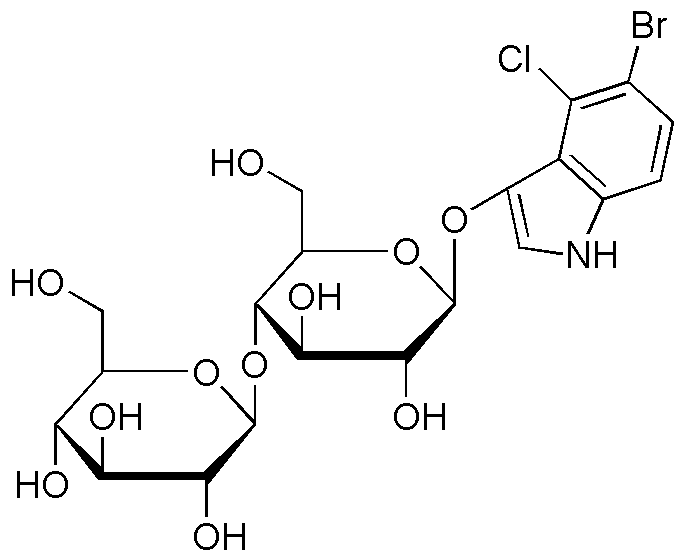5-Bromo-4-chloro-3-indolyl b-D-cellobioside is widely utilized in research focused on:
- Plant Biotechnology: This compound serves as a substrate for detecting β-glucosidase activity, which is crucial in studying plant metabolism and genetic engineering.
- Drug Development: It is used in screening assays to identify compounds that can inhibit specific enzymes, aiding in the discovery of new pharmaceuticals.
- Microbial Research: The chemical is employed in studies involving microbial fermentation processes, helping researchers understand how microorganisms break down complex carbohydrates.
- Food Industry: It can be used to assess the enzymatic activity in food processing, particularly in the production of bioactive compounds from plant materials.
- Environmental Science: This compound is utilized in research to monitor soil health by studying the enzymatic activities of soil microorganisms, which are vital for nutrient cycling.
General Information
Properties
Safety and Regulations
Applications
5-Bromo-4-chloro-3-indolyl b-D-cellobioside is widely utilized in research focused on:
- Plant Biotechnology: This compound serves as a substrate for detecting β-glucosidase activity, which is crucial in studying plant metabolism and genetic engineering.
- Drug Development: It is used in screening assays to identify compounds that can inhibit specific enzymes, aiding in the discovery of new pharmaceuticals.
- Microbial Research: The chemical is employed in studies involving microbial fermentation processes, helping researchers understand how microorganisms break down complex carbohydrates.
- Food Industry: It can be used to assess the enzymatic activity in food processing, particularly in the production of bioactive compounds from plant materials.
- Environmental Science: This compound is utilized in research to monitor soil health by studying the enzymatic activities of soil microorganisms, which are vital for nutrient cycling.
Documents
Safety Data Sheets (SDS)
The SDS provides comprehensive safety information on handling, storage, and disposal of the product.
Product Specification (PS)
The PS provides a comprehensive breakdown of the product’s properties, including chemical composition, physical state, purity, and storage requirements. It also details acceptable quality ranges and the product's intended applications.
Certificates of Analysis (COA)
Search for Certificates of Analysis (COA) by entering the products Lot Number. Lot and Batch Numbers can be found on a product’s label following the words ‘Lot’ or ‘Batch’.
*Catalog Number
*Lot Number
Certificates Of Origin (COO)
This COO confirms the country where the product was manufactured, and also details the materials and components used in it and whether it is derived from natural, synthetic, or other specific sources. This certificate may be required for customs, trade, and regulatory compliance.
*Catalog Number
*Lot Number
Safety Data Sheets (SDS)
The SDS provides comprehensive safety information on handling, storage, and disposal of the product.
DownloadProduct Specification (PS)
The PS provides a comprehensive breakdown of the product’s properties, including chemical composition, physical state, purity, and storage requirements. It also details acceptable quality ranges and the product's intended applications.
DownloadCertificates of Analysis (COA)
Search for Certificates of Analysis (COA) by entering the products Lot Number. Lot and Batch Numbers can be found on a product’s label following the words ‘Lot’ or ‘Batch’.
*Catalog Number
*Lot Number
Certificates Of Origin (COO)
This COO confirms the country where the product was manufactured, and also details the materials and components used in it and whether it is derived from natural, synthetic, or other specific sources. This certificate may be required for customs, trade, and regulatory compliance.


